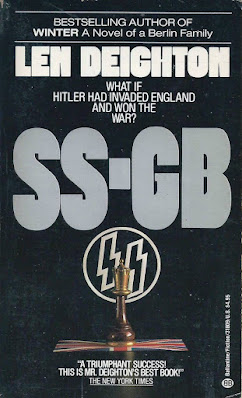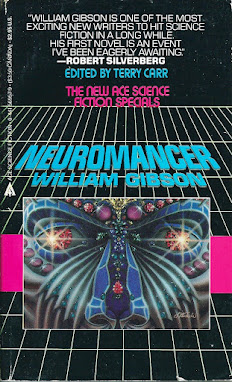May is 'Third Reich Triumphant' Month at the PorPor Books Blog
Book Review: 'SS-GB' by Len Deighton
'SS-GB' first was published in hardcover in 1978. This Ballantine Books mass-market paperback edition was issued in March, 1980.
The novel is set in an alternate timeline where, in February 1941, Hitler succeeds in conquering the UK. Winston Churchill is executed and King George imprisoned in the Tower of London. Prisoner of War camps are established in the countryside, and the German military police maintain checkpoints throughout London. Rationing is universal, and privation and tightened belts are a fact of life.
As the novel opens it's November, and the cloudy skies, and the drizzle falling on ruined buildings, imparts a grim aspect to London. Lead character Detective Superintendent Douglas Archer of Scotland Yard, is by now accustomed to working under the supervision of SS General Fritz Kellerman. While outwardly avuncular and even-tempered, Kellerman is, in reality, adept at manipulating (to his own advantage) the ongoing political and bureaucratic infighting between the SS and the Army. Each faction: Army and SS, seeks to be the dominant power in charge of the occupation government, and the English can do no more than look on with the passivity of a defeated people.
Kellerman, who holds Archer in high regard, dispatches the detective to investigate a murder in a flat in London's Shepherd Market neighborhood. The deceased man has been shot to death, but also bears strange burn marks on his arms. The owner of the flat is a known operator in the black market, and may have ties to the British Resistance.
However mundane the murder may at first appear, it has provoked Heinrich Himmler to send SS Standartenfuhrer Oskar Huth to London to supervise the investigation. Huth intimates to a bewildered Douglas Archer that the German government has a keen interest in the activities of the dead man. And thus Archer finds himself entering a maze of conspiracies and unlikely alliances, all centered on the scientific research being conducted at a German physics laboratory on the Devon coast. Research that has the potential to determine the polity that rules the world in the last half of the twentieth century........
I approached 'SS-GB' with some skepticism, since the Len Deighton novels (such as 'The Ipcress File,' and 'Funeral in Berlin') I have read in the past, were talky and dull. But 'SS-GB' is, to its credit, a livelier novel despite its length of 375 pages. Deighton is very good at crafting a believable incarnation of the UK under Nazi rule. While the narrative primarily is framed as a detective novel, Deighton inserts enough story beats to keep the plot from being overwhelmed by the details of the investigative process. The book's denouement is genuinely suspenseful and contain some twists and turns designed to avoid a pat outcome.
For me, the novel's closing chapters cause it to lose a ratings star. These chapters are meant to explicate various plot developments, but come across overly reliant on coincidence and contrivance, and some rather forced behaviors on the part of some of the major characters.
Taken all in all, 'SS-GB' is a solid Four Star novel, and one of the better speculations into what a Third Reich Victorious scenario would entail.





















































.jpg)



















